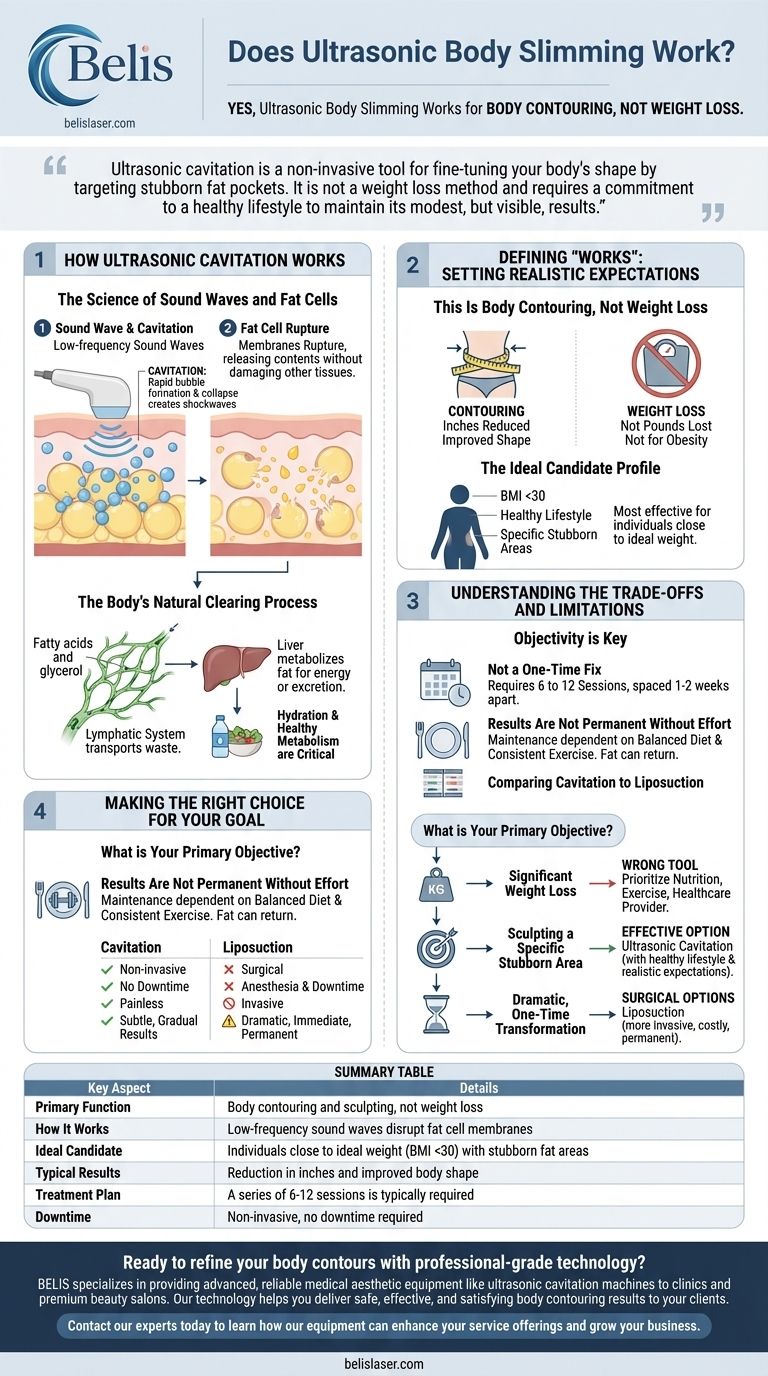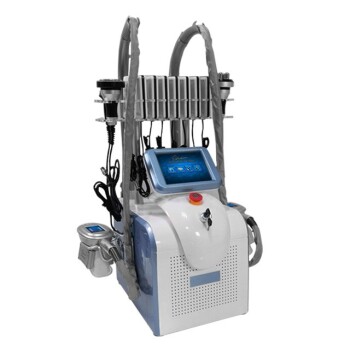Yes, ultrasonic body slimming works, but its function is for body contouring, not weight loss. The technology, known as ultrasonic cavitation, can effectively reduce localized fat deposits and improve the shape of specific areas. However, it is not a solution for significant weight reduction and its results are highly dependent on the individual and their lifestyle.
Ultrasonic cavitation is a non-invasive tool for fine-tuning your body's shape by targeting stubborn fat pockets. It is not a weight loss method and requires a commitment to a healthy lifestyle to maintain its modest, but visible, results.

How Ultrasonic Cavitation Works
To determine if this technology is right for you, it's essential to understand its underlying mechanism. This is not a magic wand but a targeted application of physics.
The Science of Sound Waves and Fat Cells
Ultrasonic cavitation uses low-frequency sound waves to create microscopic bubbles within the interstitial fluid surrounding your fat cells.
These bubbles rapidly expand and collapse in a process called cavitation. This creates a localized shockwave that puts stress on the fat cell membranes.
The pressure eventually causes the adipocyte (fat cell) membranes to rupture, releasing their contents—triglycerides—into the surrounding fluid without damaging other tissues like skin or nerves.
The Body's Natural Clearing Process
Once the fat is released from the cell, it is not gone. Your body's lymphatic system must transport the fatty acids and glycerol to the liver.
The liver then processes this fat, metabolizing it for energy or excreting it from the body. This is why hydration and a healthy metabolism are critical for the treatment to be effective.
Defining "Works": Setting Realistic Expectations
The term "works" is relative. For ultrasonic cavitation, success is measured in inches and improved contours, not in pounds lost on a scale.
This Is Body Contouring, Not Weight Loss
Ultrasonic cavitation does not destroy a large volume of fat cells in the way surgical procedures do. It is best understood as a sculpting tool.
It is designed to address stubborn pockets of fat that persist despite a healthy diet and regular exercise, such as on the lower abdomen, "love handles," or outer thighs.
The Ideal Candidate Profile
The technology is most effective for individuals who are already close to their ideal body weight.
The ideal candidate has a Body Mass Index (BMI) under 30, maintains a healthy lifestyle, and has specific, localized problem areas they wish to improve. It is not suitable for treating obesity.
Understanding the Trade-offs and Limitations
Objectivity requires acknowledging that every technology has its limitations. Ultrasonic cavitation is non-invasive, which brings both benefits and compromises.
It Is Not a One-Time Fix
A single session will not produce a noticeable result. A typical treatment plan involves a series of 6 to 12 sessions, often spaced one or two weeks apart, to achieve the desired outcome.
Results Are Not Permanent Without Effort
While the treated fat cells are disrupted, the body can easily store new fat in the remaining cells if you consume more calories than you burn.
Maintaining the results of ultrasonic cavitation is entirely dependent on your commitment to a balanced diet and consistent exercise. Without this, the fat will return.
Comparing Cavitation to Liposuction
Liposuction is a surgical procedure that physically removes a large volume of fat cells from the body permanently. It is invasive, requires anesthesia, and has significant downtime.
Ultrasonic cavitation is non-invasive, requires no downtime, and is painless. However, its results are far more subtle and gradual compared to the dramatic and immediate changes seen with liposuction.
Making the Right Choice for Your Goal
To decide if this treatment is a worthwhile investment, align the technology's capabilities with your primary objective.
- If your primary focus is significant weight loss: This is the wrong tool. Prioritize a comprehensive plan involving nutrition, exercise, and consultation with a healthcare provider.
- If your primary focus is sculpting a specific, stubborn area: Ultrasonic cavitation can be an effective, non-invasive option, provided you are already living a healthy lifestyle and have realistic expectations.
- If your primary focus is a dramatic, one-time transformation: Surgical options like liposuction, while more invasive and costly, provide more significant and permanent fat removal.
Understanding the precise role of ultrasonic cavitation empowers you to use it as an effective tool for its intended purpose: fine-tuning, not foundational change.
Summary Table:
| Key Aspect | Details |
|---|---|
| Primary Function | Body contouring and sculpting, not weight loss |
| How It Works | Uses low-frequency sound waves to disrupt fat cell membranes |
| Ideal Candidate | Individuals close to ideal weight (BMI <30) with stubborn fat areas |
| Typical Results | Reduction in inches and improved body shape |
| Treatment Plan | A series of 6-12 sessions is typically required |
| Downtime | Non-invasive, no downtime required |
Ready to refine your body contours with professional-grade technology?
BELIS specializes in providing advanced, reliable medical aesthetic equipment like ultrasonic cavitation machines to clinics and premium beauty salons. Our technology helps you deliver safe, effective, and satisfying body contouring results to your clients.
Contact our experts today to learn how our equipment can enhance your service offerings and grow your business.
Visual Guide

Related Products
- Ultrasonic Cavitation Radiofrecuency Machine for Body Slimming
- EMSlim RG Laser Body Sculpting and Slimming Machine
- EMSlim Body Sculpting Machine EMS Body Slimming Machine
- EMS Body Sculpting Machine for Body Slimming and Sculpting
- EMS Body Sculpting Slimming Machine EMSlim Body Slimming Machine
People Also Ask
- When should you not use a cavitation machine? Critical Safety Guidelines for Aesthetic Treatments
- Where does fat go after cavitation? Understand the Journey from Cell to Elimination
- Does cavitation get rid of belly fat? Yes, Here's How It Works for Body Sculpting
- Does cavitation destroy fat cells permanently? Yes, for targeted, stubborn fat reduction.
- Does ultrasound really break down fat? Discover the Science of Non-Invasive Fat Reduction



















